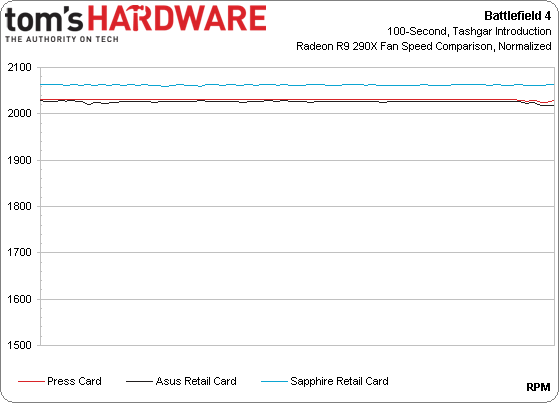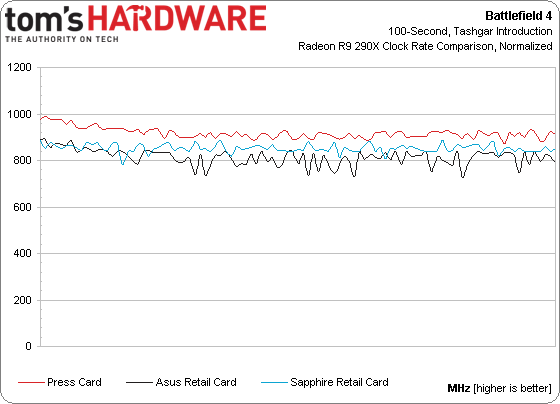The Cause Of And Fix For Radeon R9 290X And 290 Inconsistency
We first observed differences between the Radeon R9 290X cards that AMD sent out for review and the ones being sold online just before our R9 290 coverage went live. After additional testing, we have answers, feedback from AMD, and more questions.
Can We Fix The Variance Ourselves?
The next step was to start fiddling with the Catalyst Control Center’s OverDrive applet to see if we could manually dial in equivalent fan speeds and solve the issue ourselves. On Asus’ card, a 43% maximum duty cycle got us as close as possible to AMD’s press board. Sapphire’s R9 290X needed a 42% override to get there. The outcome isn’t exact, but with 1% granularity in AMD’s driver, it’s impossible to get any closer.
The press and Asus cards are almost identical, but Sapphire’s fan is spinning about 30 RPM quicker. In theory, that only means it should perform better than AMD’s sample, if anything.
Asus’ R9 290X comes off of its 727 MHz floor with an extra 200 RPM of fan speed to help clock rates. Its new average is 792 MHz. Adding 100 RPM to Sapphire’s ceiling also helps, increasing that board’s average from 809 to 852 MHz. But neither retail-purchased product is able to catch the card we first received from AMD, which averages 917 MHz.
Even when we bring the retail cards up to the press board’s fan speed (and beyond), they are not as fast. In fact, our press board is still more than 11% quicker than Asus Radeon R9 290X. It’s 7% faster than Sapphire’s.
Get Tom's Hardware's best news and in-depth reviews, straight to your inbox.
Current page: Can We Fix The Variance Ourselves?
Prev Page The Difference Between My R9 290X And Yours Next Page AMD’s Solution Surfaces-
tttttc I never understand why ANYONE will buy the reference design cards.... even for the GTX780, the aftermarket cooler is way better and quieter than the stock fan.Reply -
eldragon0 Thank you so much for this article, I've been waiting on a write-up of this sort. There is one thing I'd love to see. Assuming the 290 and the 290x have the same layout, is it possible for you to strap that aftermarket heatsink onto each of them and give us a comparison of both of them at retail without them being horribly throttled? I'd love nothing more than to see a 290 and a 290x head to head at full speeds !Reply -
itzsnypah Reply11889637 said:This kind of thing is why I use msi afterburner. Just set your own fan curve.
That is not how powertune works.
It's: Get Hot -> Get loud -> Drop clocks -> Get as loud as necessary to keep GPU from melting.
So having a 'custom' fan curve does nigh nothing.
E: I wonder what would happen if you fed the card hot air. What happens when you're at 100% fan speed and still pushing 96c+? Does it shut down, clock down even more or melt? -
FormatC Replyis it possible for you to strap that aftermarket heatsink onto each of them
It is impossible. The reason is simple: thermal clue. As I wrote in my article about the thermal grease: after the burn-in it is nearly impossible to remove the small heatsinks. The risk to destroy the card is too high. This aftermarket cooler is good and quiet but it is a real one-way ticket. You can't return ;)
For addition - I've done the same thing with R9 290 cards and another benchmark before AMD has changed the driver. We worked hard to detect the reason for this big variances. But it seems that the difference between the R9 290 cards is a little bit smaller.
This was before:
-
Quaddro Praise this card..Reply
Now we can see 780Ti and 780 with more reasonable price..;)
Still waiting msi hawk version or directCu version of both of this card..hope that series will handle the heat..
Spend $100 more just for cooler (mk-26 + 2 fans) on reference card, is not a really good option.. -
Nintendo Maniac 64 I wonder if the rest of the performance difference now boils down to how the stock thermal paste was applied.Reply -
FormatC This I've tested too. No mentionable differences. May be my cards were assembled by a very accurate robot ;)Reply
The voltage is a little bit different:
But this is not strange. Typical tolerance. -
iam2thecrowe I cant stand all this variable clock rate BS ever since it was introduced in nvidia and amd cards. the card throttles in the most demanding scenario's, where you need it not to throttle, so the "boost clock" speeds are just there to inflate benchmark figures without any improvement in real world performance. On my cards, i force a stable clock speed with Nvidia inspector, negating boost clock, games run more stable and predictably, the way it should be.Reply
p.s. the add for nail fungus you have on your page toms, nearly made me vomit. please no more nail fungus adds!!!!!!!



